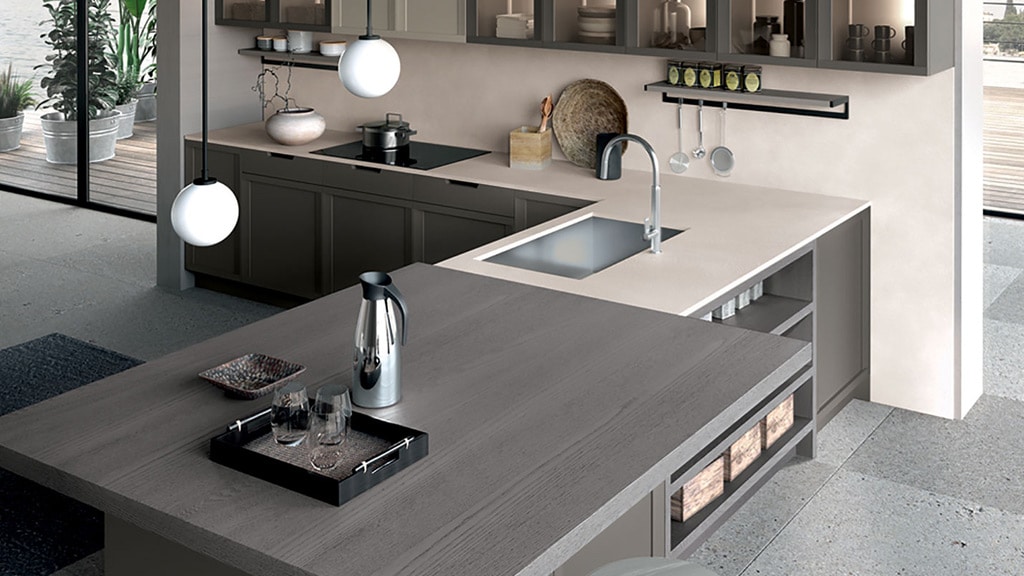“W hen we talk about the maintenance and cleaning of the kitchen top, it is of fundamental importance to take into account the material with which the top is made.
Whether it is marble, granite, laminate, quartz, steel or ceramic, there are some tips that are valid for all kitchen tops.
It is a good idea to use pot rests to avoid heat stains: hot pans, other cooking containers or coffee pots placed directly on the tops can damage them irreparably. Furthermore, excessive and concentrated weights can cause breakages and cracks in the material and it is advisable to never climb or sit on the tops. Also try to remember that pots and pans must not protrude from the hob, so as not to damage it with heat. Also avoid dragging objects on the hob that could scratch it and, in the case of using knives or sharp objects, always use a cutting board, to avoid permanent damage to the hob.
In our manual, we see how to best clean the kitchen top based on the material.

How to clean the laminate kitchen top
To clean the laminate kitchen top in the best possible way, it is necessary that there is no stagnation of water, so it is necessary to dry the top where it may have accidentally fallen and make sure that there is no water drips along the edges. For cleaning, always avoid abrasive materials such as steel wool or products containing abrasive creams or powder detergents and Acetone, Trielina, Ammonia. The risk of discolouration can also be caused by fruit juices and chemicals and health care products: remember to remove them immediately after use.
How to treat a Fenix® top
The Fenix® top has high-performance characteristics in terms of self-repair from not deep scratches. It does not need any particular maintenance but the surfaces must be cleaned regularly. Therefore, immediately remove liquids or residues of food and condiments: in particular, water with a high content of limestone, if it evaporates on the top, can create halos, which can be eliminated with daily cleaning. For routine maintenance, we recommend the use of a melamine foam sponge (also known as magic rubber): use the dry sponge by rubbing the affected part after drying the top. If the dirt remains, a damp microfibre cloth with hot water and detergents is recommended (in particular, a descaler such as Chanteclair is recommended). All household cleaners or disinfectants are also well tolerated. For extraordinary maintenance, in the presence of traces of dirt that cannot be removed with normal detergents, we recommend using non-aggressive aromatic solvents such as acetone. In the case of micro-scratches, it is necessary to follow the instructions for repairing the surface indicated in the specification sheets.
Maintenance for HPL tops
HPL surfaces have good resistance to household chemicals. For maintenance, it is good practice to always keep the hob clean and dry. In case of stubborn dirt or carelessness, first remove any deposits of dry material with a soft, damp cloth, without rubbing so as not to scratch the door. Then use a soft non-abrasive sponge and a household detergent (Chanteclair descaler again), wash the surface with the detergent and rinse with plenty of warm water, then dry well. To clean the HPL top you can also use acetone, being extremely careful not to let it come into contact with any plastic edges.
The tops in okite® or quartz agglomerates
All hard surface cleaning products can be used on these floors. We advise you to carefully rinse the top in order to remove any soap residues. The use of basic degreasers should also be avoided. For limescale stains, we recommend the use of acid-based descaling detergents (such as Viakal). Normally dark and opaque products have a tendency to highlight the dirt more and therefore greater care is required to keep the surface clean; however, this does not affect the resistance and reliability characteristics of the top, which remain unchanged for all colours.
How to clean marble and granite kitchen countertops (natural stone)
For proper maintenance of a marble or granite kitchen top, avoid citric acid (present for example in fruit in tomatoes and citrus fruits) which acts on the glossy surface, removing its original brilliance. Even cleaning products or food liquids such as oil, wine, vinegar, if not removed immediately after contact with the hob can damage it.
How to clean a Dekton® kitchen counter
Dekton® is a precious material and is increasingly used in kitchen countertops. It is a mixture of glass, ceramic materials and quartz. This material is distinguished by its extremely compact surface without defects and is very resistant to pressure, scratches, shocks and high temperatures. It also has water-repellent properties and is immune to oil, vinegar and lemon stains, remaining unchanged over time. To clean a Dekton® top, we recommend the daily use of a neutral detergent, applying it with a soft cloth, then rinsing it with a damp microfibre sponge. In the colors that have a glossy finish, we advise you to finally dry the surface of the top with a paper or a cotton cloth. Finally, although very resistant, be careful in using chemicals such as bleach and acids.
The tops in maxfine technical ceramics
Maxfine technical ceramics (Iris) are a material produced with noble clays such as quartz, feldspar and sintered kaolins, consisting of a compact, frost-proof, non-absorbent and resistant to chemical and physical attacks. This material is subject to minimal color variations. How is it cleaned?
The veneered and solid wood tops
For these types of tops, do not use alcohol or stain removers. Any liquid deposits must be dried immediately to avoid absorption alterations. Absolutely avoid the use of acetone, trichlorethylene, ammonia or detergents that contain it.

